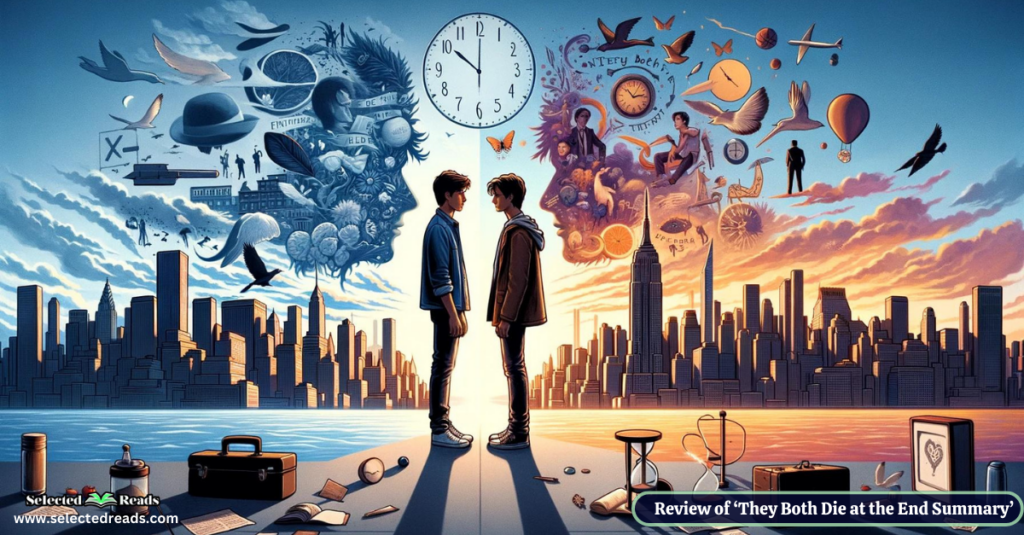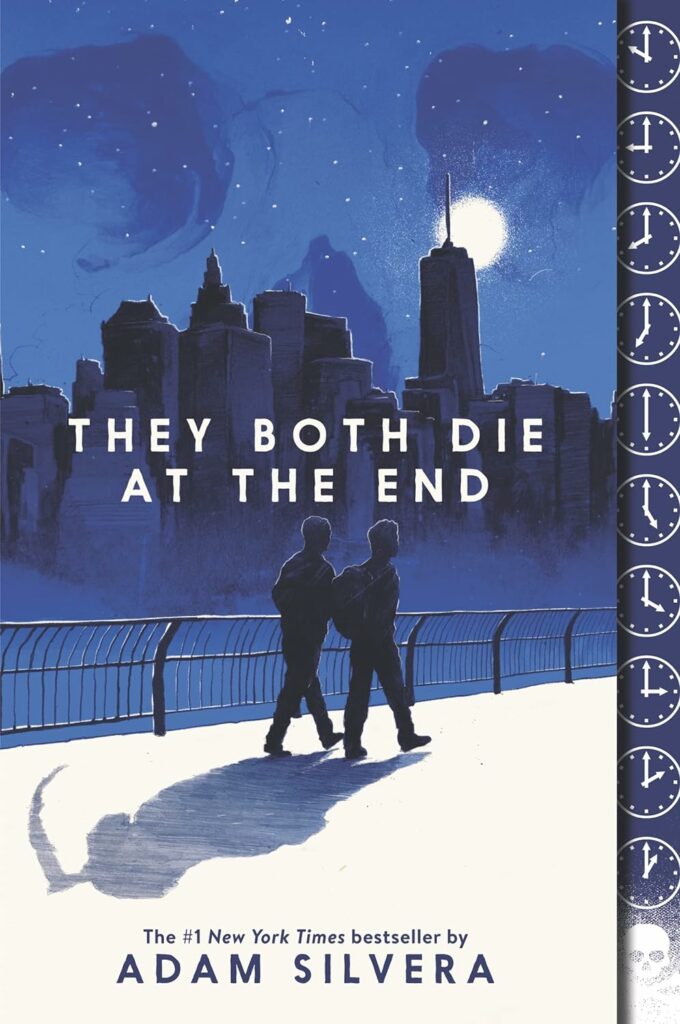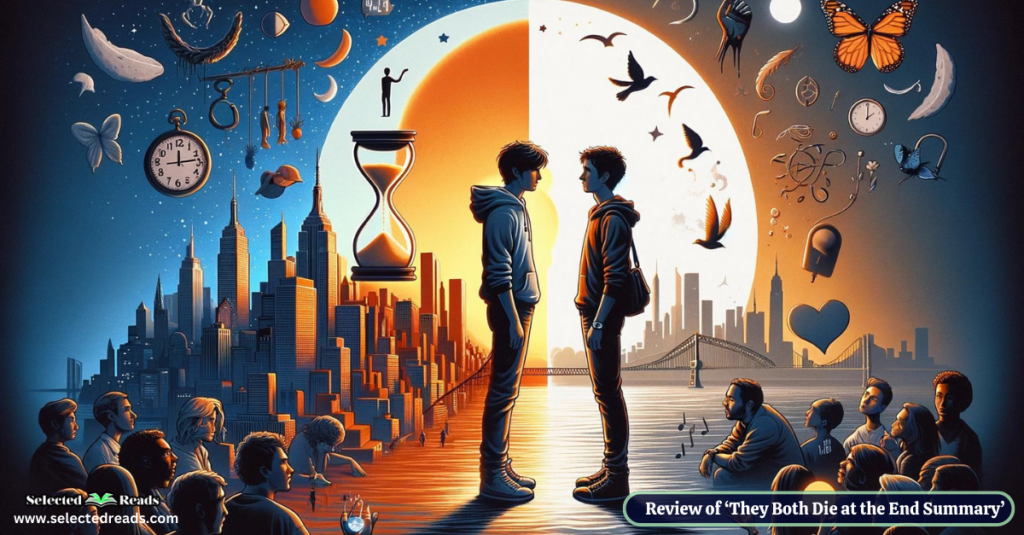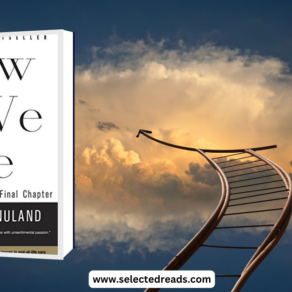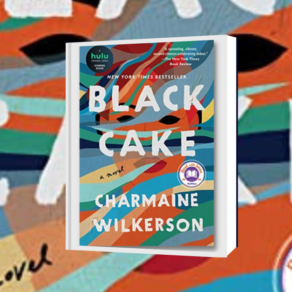Our analytic focus in today’s post is on Silvera’s epic novel “They Both Die at the End.” We delve into the intricacies of a story that weaves together the inevitability of death with the indomitable spirit of human connection. This narrative invites us into the lives of two teenagers, Mateo Torrez and Rufus Emeterio, who receive the foreboding news that their lives will end within the next twenty-four hours. Through an extended summary, we’ll traverse the emotional landscapes that Silvera paints, uncovering the layers of experiences and choices that define Mateo and Rufus’s final day.
Besides the summary, our discussion will also cover characters, from the introspective Mateo to the brash yet tender Rufus, each character contributes to the rich tapestry of themes the novel explores. Next, we unpack the central themes of the novel then we conclude with a set of thought-provoking book club questions.
They Both Die at the End Summary
In the early hours of September 5, Mateo Torrez and Rufus Emeterio, two teenagers living in New York City, receive the life-altering calls from Death-Cast, informing them that their end is imminent within the next twenty-four hours. Despite their vastly different backgrounds and personalities—Mateo is introverted and cautious, having lived a sheltered life partly due to his deep fears and the loss of his parents, while Rufus is more of an extrovert, dealing with his own grief after losing his family in an accident—they are thrust into the same harrowing reality of confronting their mortality.
The narrative takes off when Mateo and Rufus, seeking companionship on their final day, connect through an app called Last Friend. What starts as a digital interaction quickly evolves into a profound bond, as they decide to spend their final hours together, making the most of the time they have left. The novel follows their adventures across the city as they attempt to live a lifetime in a single day, embracing experiences they’ve either feared or never considered, from small acts of kindness and simple joys to confronting personal fears and mending broken relationships.
Throughout their journey, Silvera masterfully interweaves themes of love, friendship, acceptance, and regret. The characters encounter various people who also grapple with the concept of mortality in different ways, providing broader reflections on how society might adapt to the knowledge of when someone is going to die. Through their interactions and the choices they make, Mateo and Rufus learn about themselves and each other, growing and changing in ways that are both profound and heartbreakingly human.
The beauty of “They Both Die at the End” lies in its exploration of the meaning of life when framed by the inevitability of death. Silvera posits a world where the foreknowledge of death serves as a catalyst for living more fully, highlighting the paradox of how an end can give rise to a beginning—of new relationships, understandings, and the courage to live authentically.
Photo: Amazon
As the title forewarns, the story concludes with both Mateo and Rufus meeting their end, but not before they’ve transformed each other’s lives in significant and lasting ways. Their story is a testament to the power of human connection and the indelible impact of living life to the fullest, even in its final moments.
Reflecting on this narrative, it’s impossible not to contemplate the ways in which we lead our own lives. The story serves as a reminder to cherish every moment, to seek out connections that enrich and empower us, and to live in a way that, when our own end comes, we can look back with no regrets. In sharing Mateo and Rufus’s story, Silvera not only crafts a moving tale but also invites us to reflect on the depth and breadth of our own experiences and the legacies we hope to leave behind.
Related: If We Were Villains Summary, Characters, and Book Club Questions
They Both Die at the End Themes
The novel “They Both Die at the End” by Adam Silvera explores several poignant themes that resonate deeply with readers, offering much to ponder about life, relationships, and the human condition. Here are some of the central themes:
- Mortality and the Awareness of Death: The premise of the novel, where characters are informed of their impending death, brings the theme of mortality to the forefront. This awareness prompts a reflection on how the knowledge of one’s death can affect choices, relationships, and personal growth. It challenges both characters and readers to consider how they would live if they knew they had only one day left.
- Living Life to the Fullest: Closely tied to the theme of mortality, the story encourages embracing life fully, exploring new experiences, and stepping out of comfort zones. Mateo and Rufus’s journey is a testament to the idea that life’s value is not necessarily in its length, but in its depth and the quality of experiences.
- The Importance of Connections: The novel places a strong emphasis on human connections, friendships, and relationships. Through the Last Friend app and the interactions between Mateo, Rufus, and others they meet on their final day, Silvera explores how meaningful connections can significantly impact lives, even in a short amount of time.
- Identity and Self-Discovery: Both protagonists undergo significant self-discovery throughout their final day. Faced with the end, they confront their fears, desires, and regrets, leading to profound personal growth and a better understanding of who they are and who they want to be.
- Acceptance and Letting Go: As Mateo and Rufus come to terms with their fate, themes of acceptance and letting go emerge. This theme extends to dealing with past traumas, forgiveness, and reconciling with one’s own life choices and the inevitable end that everyone faces.
- Queer Representation and Love: The story also contributes to the representation of LGBTQ+ characters in young adult literature. The exploration of queer relationships, identity, and the portrayal of Rufus and Mateo’s bond adds depth to the narrative, presenting love in its many forms, unbounded by societal norms.
- Courage and Bravery: The courage to face one’s end and to live authentically, despite the fear of judgment or making mistakes, is a recurring theme. It’s not just about the bravery in facing death, but also in embracing life’s challenges, opening up to others, and pursuing genuine connections and experiences.
They Both Die at the End Characters
“They Both Die at the End” is a deeply character-driven novel with a small but crucial cast of characters. Here are the main characters:
- Mateo Torrez: One of the two protagonists of the story, Mateo is an 18-year-old Puerto Rican-American living in New York. He’s shy, introverted, and lives a cautious life, preferring to stay at home and avoid risks. Upon receiving his Death-Cast call, he decides to make the most of his final day.
- Rufus Emeterio: The other protagonist, Rufus, is a 17-year-old Cuban-American boy, who’s more extroverted and daring than Mateo. He receives his Death-Cast call while beating up his ex-girlfriend’s new boyfriend, which leads him to seek a ‘Last Friend’ to spend his remaining time with.
- Peck: Rufus’s best friend, who is supportive and understanding. He is part of the ‘Plutos,’ Rufus’s chosen family after his own parents’ and sister’s deaths.
- Tagoe and Malcolm: Other members of the ‘Plutos,’ Rufus’s close-knit group of friends.
- Lidia: Mateo’s best friend and the mother of his goddaughter, Penny. She lost her boyfriend and the father of her child a year before the story begins.
- Aimee: Rufus’s ex-girlfriend, whom he still has feelings for.
They Both Die at The Book Club Questions
“The Both Die at the End” by Adam Silvera poses thought-provoking questions about life, death, and relationships, making it a great choice for book club discussions. Here are some questions to consider:
- How do you think you would react if you received a call from Death-Cast? What would you do with your last day?
- Discuss the concept of the ‘Last Friend’ app. Do you think a tool like this would be beneficial in real life for people facing the end of their life?
- How do Mateo and Rufus’s characters evolve throughout their final day? What changes do you see in them from the beginning to the end of the story?
- Explore the theme of courage in the book. How do the characters exhibit bravery in the face of their impending deaths?
- What did you think of the author’s decision to have both characters die at the end, as suggested by the title? Did you hope for a different outcome?
- The novel explores the idea of a ‘lifetime in a day.’ How do Mateo and Rufus manage to live a lifetime’s worth of experiences in their final hours?
- Discuss the relationships in the book—not just between Mateo and Rufus, but also their relationships with other characters like Lidia, Peck, Tagoe, Malcolm, and Aimee. How do these relationships impact the story?
- What message do you think the author is trying to convey about life, death, and making the most of the time we have?
- How did the interspersed narratives of other characters receiving Death-Cast calls contribute to the story?
- What were your thoughts on the world-building in the book? How did the author’s depiction of a society aware of their exact death date affect the overall atmosphere and tone of the novel?
Final thoughts
Adam Silvera’s novel “They Both Die at the End” serves as a poignant reminder of the fragility and preciousness of life. Through the intertwined journeys of Mateo Torrez and Rufus Emeterio, Silvera confronts us with the inevitability of death, while simultaneously celebrating the beauty of life lived to its fullest. The characters, themes, and the emotional tapestry woven throughout this narrative invite readers to reflect on their own lives, relationships, and the impact of the choices we make every day.



